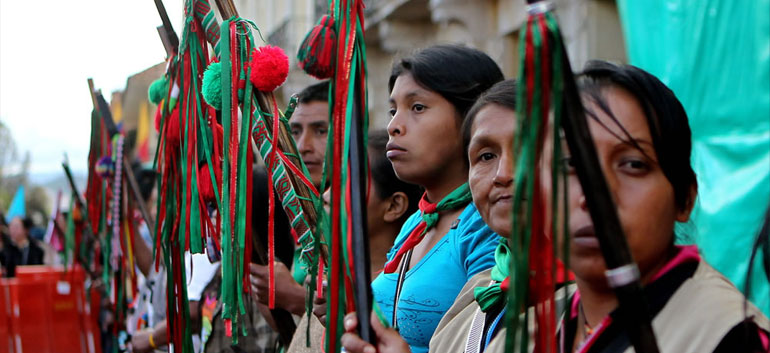The “Indigenous Guard,” the police of Colombia’s native minorities, regularly hit the headlines when confronting guerrilla groups like the FARC or even the military. But the guards have a wider role throughout indigenous Colombia, and face challenges in adapting to the future.
The Guardia Indigena originated in the indigenous movement of Cauca, a south western state that has long been afflicted with land disputes and a three-way armed conflict involving the security forces, the FARC, and paramilitaries.
In Cauca there are now around 10,000 indigenous guards, almost the same number as security services personnel (11,400), and the concept has spread to other indigenous communities throughout Colombia.
Despite the fame they earned through confronting armed actors, their social and cultural function is less well known. The guards were given responsibility for protecting civilians and indigenous territory by the indigenous councils formed after the 1991 Constitution.
“But they also have a spiritual mission. As a ‘peaceful army’ they embody that spirituality, and also assist in rites of traditional medicine or ceremonies for Pachamama (Mother Earth) and Father Sun,” Santiago Gutierrez, a researcher of the role of the Guardia, told Colombia Reports.
Men, women and children may all serve as guards, and on being appointed as guards by their communities they are presented with ceremonial staves of office, which are blessed by a “teguala” traditional doctor in a ceremony by a lagoon.
Posado sees the ideal of the Guardia as being a pacifist force that confronts the army and guerrillas using the moral and legal authority of indigenous communities through their councils, but in reality when an attack or violation has occurred that pacifism has not been absolute.
The shooting dead of two guards outside Toribio, Cauca in November appears to have occurred after the Guardia sought to physically arrest members of the FARC who had been erecting propaganda on indigenous land.
MORE: FARC accused of killing 2 members of southwest Colombia indigenous community
As in any organization, says Posado, members of the Guardia have misused their position for personal gain or not lived up to the expectations of the community. Bogota-based newspaper El Tiempo also reported rumors that some guard leaders turned community resistance into a business, handling funds from agencies for international cooperation, not all of which reached the community.
If maintaining discipline is one challenge, many others are presenting themselves that are currently obscured by the continuous intrusion of the armed conflict into indigenous land. Posado argues that if a peace agreement is signed between the government and the guerrillas, the focus of the guards will shift to confronting the expansion of the mining sector into indigenous communities.
MORE: Southwest Colombia indigenous demand army cease activities on their territory
“The Guardia Indigena will have more responsibility maintain customs and culture, and to protect territory from national institutions and multinational companies; it will need to concentrate its ideas and activities more in the economic sphere.”
A grave threat to the future of indigenous communities, he says, is the loss of indigenous customs and culture through multinationals exploiting indigenous territory. “If the Guardia allows this,” he says, “it will erode everything.”
Sources
- Interview with Santiago Gutierrez Posada
- Guardia indígena, el poder oculto que empieza a verse en el Cauca (El Pais)


